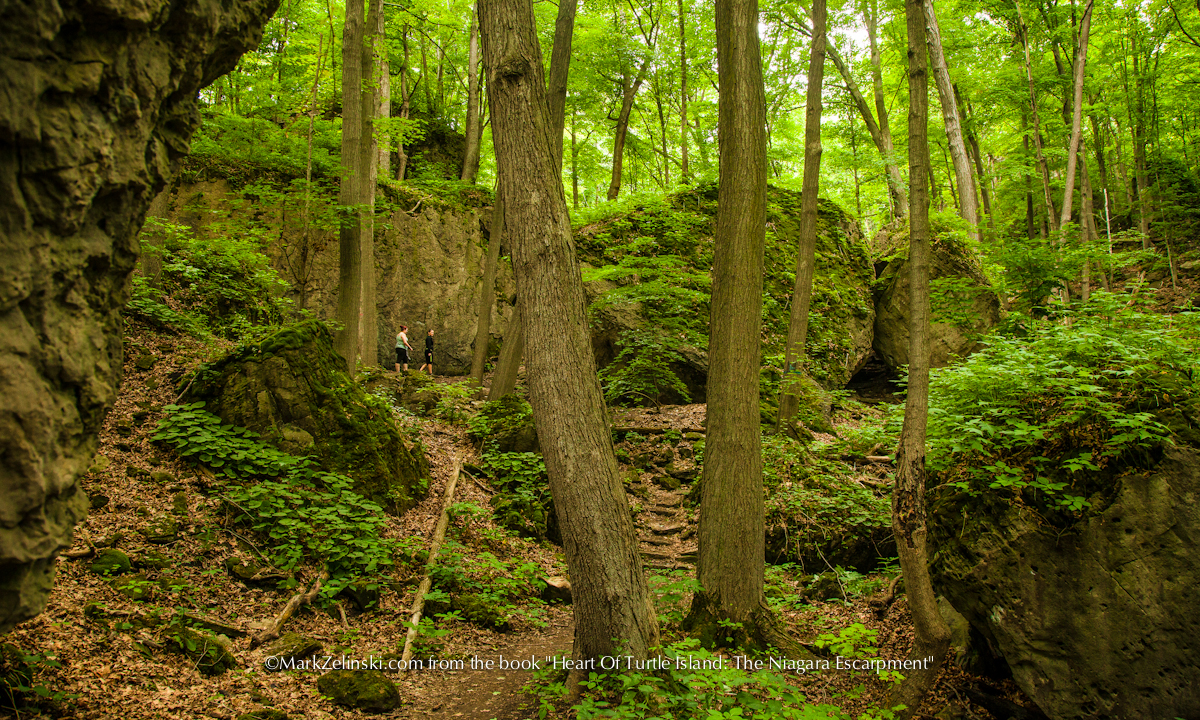NIAGARA ESCARPMENT BIOSPHERE NETWORK BLOG
12/03/2023
Under Our Feet
12/03/2023

The Niagara Escarpment’s talus slope is the keystone to its biodiversity. The soils and subterranean habitats found in the talus provides the medium for the abundance and diversity of life.
The talus slope is composed of rocks and rubble that have broken off of the escarpment face since the glaciers retreated. These unorganized rock piles provide for plenty of voids in the talus. Over time in most places the eroded rocks have been infiltrated and covered by rubble and organic debris forming thin layers or pockets of loose well drained soils.
The talus slope houses a rare and interesting life zone which we seldom think of. It provides subterranean habitats with stable consistent moisture levels and temperatures. It is a habitat where darkness prevails. Precipitation and melt waters percolate down through the talus. Waters emerge from the base of the talus as springs, or they can drain further and replenish ground waters.
There is usually enough soil on the talus to support the escarpment’s rich forests that keeps the talus shaded and cool. Frost may penetrate a meter. A meter down will have a temperature well above freezing all year varying slightly and there is constant high humidity. Cold blooded animals, such as snakes and salamanders, requiring stable places for hibernating can easily find a void in the talus to shelter in. Animals requiring constant humidity rely on the moisture and cool soils.
The Red-backed Salamander, a common inhabitant of the talus, finds the talus a perfect place to live. The loose soils and frequent voids allow for vertical and horizontal travel for these subterranean animals. The Ring-necked Snake, also an animal of talus slopes, feeds on Red-backed Salamanders. This snake is nocturnal and considered rare across its range. But is it rare in the underground tangles of a talus slope? Does the time of day really make a difference to this snake? Day or night makes no difference as it can follow favourable scents to find its way to food and mates.
Endangered species like Jefferson’s Salamanders can be totally dependent on the talus slopes as the land below or on top of the escarpment has often been deforested and the dense compacted soils experience great ranges of temperature and humidity. These sites are unsuitable to most amphibians. The talus slope provides the last refuge for such species in many areas of Southern Ontario.
Animals living in the talus slope do not have to worry about being flooded out of their dens for the talus drains well. Mammals of all sizes can find hibernaculums or den sites in the talus.
Invertebrates, bacteria, fungi and other lower lifeforms do well in the stable talus environments. They are constantly nourished by organic debris falling on the talus slope where gravity and water force the materials to penetrate into the talus to the waiting decomposers.
The spring wildflowers of the talus slope are often far more abundant and diverse than in wooded areas away from the escarpment. Most wooded areas in Southern Ontario have sheltered livestock at one time or another. There is a relationship between the historical presence of livestock and the disappearance of many species of wildflowers. Trilliums and many species can only be eaten for so many years before they disappear. There are no quick ways for most wildflowers to move back into isolated woodlots. On the talus slope livestock were seldom found because of physical restrictions presented by the slope to livestock and farmers.
Disruptions to talus slopes has profound effect on the Niagara Escarpment’s biodiversity. Breaks in the talus prevents life from using the talus as a travel way, creating isolated pockets of gene pools. Breaks in the talus slope like roads and developments are like dams to rivers. The importance of keeping these talus slopes intact is incalculable to the biosphere’s biodiversity.
— Bruce and Laurie Mackenzie

Bruce and Laurie Mackenzie are the coordinators for the award winning Grimsby Wetlands Project, a project of the Hamilton Naturalists’ Club (HNC). Bruce is a commissioner on the Niagara Escarpment Commission and a past president of the HNC. His recent awards include the J.R. Dymond Public Service Award from Ontario Nature, Latornell Leadership Award from Conservation Ontario, and the Rt Hon. John Turner Water and Environmental Leadership Award from Niagara Peninsula Conservation Foundation.